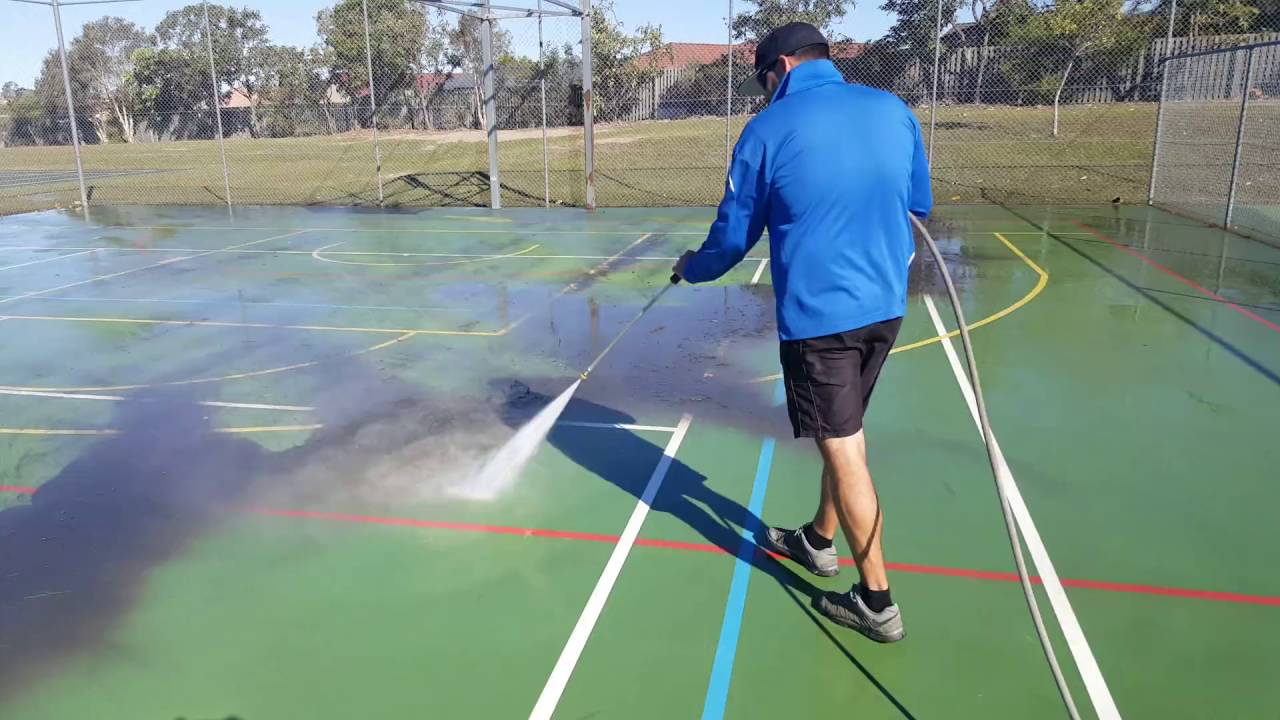
Outdoor courts are the hub of activity in parks, schools, and backyards. Whether you’re serving up aces or shooting hoops, these surfaces take a beating—collecting dust, algae, bird droppings, mildew, and even chewing gum. Over time, a dirty court can become slippery, faded, and even hazardous.
Power washing can restore the look and safety of basketball and tennis courts—but it has to be done correctly to avoid damaging the surface or erasing court lines. Let’s walk through the safest and most effective way to power wash your outdoor court. 🧼🌤️
🏀 Why Outdoor Courts Need Pressure Washing
- Dirt and dust reduce grip and traction
- Algae and mildew make surfaces slippery and unsafe
- Bird waste and gum are unsightly and hard to remove
- Regular cleaning preserves coatings and line visibility
- Helps prevent surface deterioration and costly resurfacing
🧱 What Are Courts Made Of?
Outdoor courts typically consist of:
- Concrete or asphalt base
- Acrylic sport coating or paint
- Painted lines and logos
- Optional: Rubberized or cushioned surfaces
These coatings are durable—but can be damaged by excessive pressure, hot water, or harsh chemicals. 🎯
✅ Best Tools and Equipment
- Pressure washer with adjustable PSI (ideally 1,200–2,000 PSI)
- 25° or 40° spray tip
- Surface cleaner attachment (optional for even results)
- Soft-bristle push broom or squeegee
- Biodegradable detergent safe for sport surfaces
- Safety goggles and non-slip shoes
📏 Important: Never use a zero-degree or turbo nozzle—it can etch or peel acrylic coating.
Browse Amazon Here For Top Rated Power Washers And Accessories
🪣 Step-by-Step Guide to Safe Court Washing
1. Clear the Area 🧹
Remove debris, balls, nets, and benches. Sweep leaves, branches, and dirt.
2. Spot-Treat Problem Areas 🧼
Apply mild detergent to grease stains, gum, algae, or mold. Let it dwell for 5–10 minutes.
3. Use a Surface Cleaner (Optional)
A surface cleaner ensures even pressure and avoids “striping” from inconsistent wand movement.
4. Power Wash in Sections 💦
Use a 25° or 40° tip. Hold wand 12–18 inches from surface. Spray in smooth overlapping passes. Clean from one end of the court to the other.
5. Avoid Direct Pressure on Court Lines
Court paint can flake or fade under direct spray. Reduce pressure or skip these areas and clean them by hand or from a distance.
6. Rinse Thoroughly
Flush off all detergent and grime. Work top-down on any sloped areas to prevent streaks.
7. Squeegee and Dry ☀️
Use a floor squeegee or broom to remove standing water. Let the court air dry completely.
🧪 Best Cleaning Solutions
Use only mild, pH-neutral, biodegradable detergents labeled safe for use on painted concrete or sport surfaces.
Good choices include:
- Simple Green Oxy
- Dish soap + warm water
- Tennis court-specific enzyme cleaners
Avoid bleach or acidic cleaners—they’ll dull the color and break down the surface seal.
Browse Amazon Here For Biodegradable Pressure Washing Detergents
⚠️ Common Mistakes to Avoid
❌ Using high PSI (>2,500) on painted areas
❌ Holding the nozzle too close to acrylic coating
❌ Power washing over court lines
❌ Letting water pool for hours—can cause damage
❌ Washing on extremely hot days (coating softens)
Always test in a small corner before doing the entire court.
🧽 How Often Should You Clean a Court?
- Light use (home court): Twice per year
- Moderate use (schools/gyms): Quarterly
- Heavy use (public parks): Monthly or after major weather events
- Post-storm: As needed for mud, algae, or debris
Regular power washing extends the life of your court’s coating and keeps athletes safe. 🧼🏃♂️
👷 When to Call a Pro
Hire a professional if:
- The court is large, elevated, or cracked
- There’s embedded mold or algae
- You’re unsure how to protect surface coatings
- You want a combo package (cleaning + re-striping or sealing)
Professionals use soft wash systems, surface cleaners, and sport-safe detergents to clean without damage.
🏆 Final Thoughts
Keeping your court clean isn’t just about appearances—it’s about safety, playability, and surface longevity. With the right equipment and gentle technique, power washing can rejuvenate your court and keep it game-ready year-round. 🎾🏀✨
Browse Amazon Here For Top Rated Power Washers And Accessories



